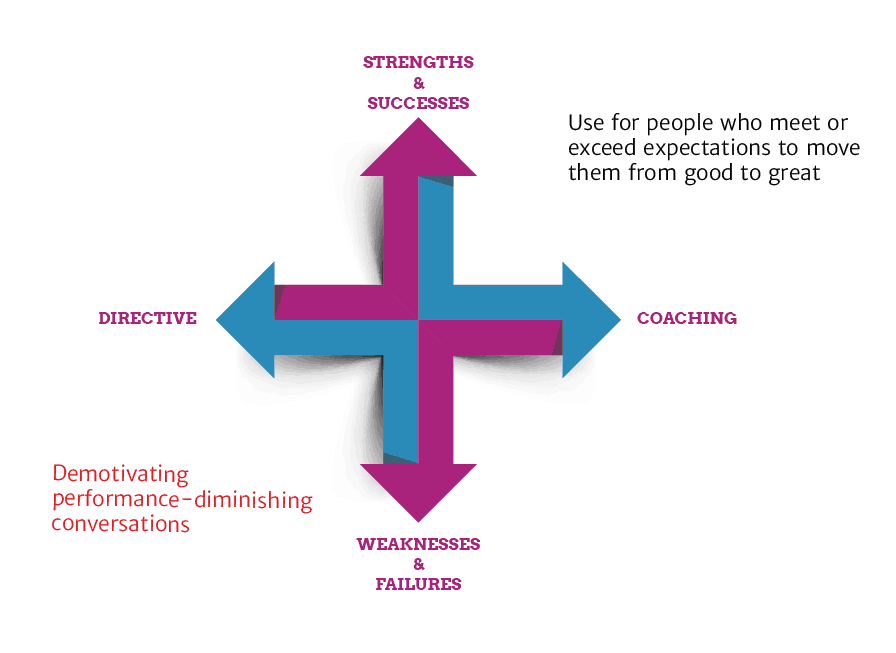Speak to most managers and employees and they will tell you that appraisals are a dreaded and demotivating experience. It is no surprise then, that according to the latest Deloitte Human Capital Trends Report, more and more organisations are now experimenting with new approaches to performance management including continuous feedback, coaching and reducing the focus on the annual appraisal.
The main source of these problems is a clash of the two conflicting purposes appraisals try to address. On the one hand they are supposed to motivate people to improve their performance and development potential. On the other, they are meant to provide a fairer basis for making reward decisions. But these purposes clash like colliding stars, giving rise to little more than debris and waves of despair and dread.However, another reason why appraisals backfire is that most have a retrospective and deficit focus, see diagram below. There are two main problems with this. Too much focus on past performance doesn’t create much space and energy to discuss future opportunities and possibilities. In a fast changing world this is particularly important as many roles are changing rapidly and a backward-looking dialogue about what’s worked in the past is unlikely to help employees succeed in future.

Perhaps the bigger problem is the heavy emphasis on negative feedback during performance conversations. This means managers typically spend a significant amount of time criticizing employees, leaving staff feeling under-valued and demotivated. It is by no means their intention and most managers hate that they have to do this. However, the process requires them to highlight areas of weaknesses against what is often a long list of competency standards. This is based on the flawed assumption that everyone can be a “well-rounded” performer and has the capability to be equally good at all aspects of their job. It also assumes that performance ‘stretch’ comes from dishing out feedback about what employees are not doing well, rather than focusing on what energises them and they are good at.

Yet performance management has the potential to be a powerful HR process, helping organisations maximise performance, engagement, and retention and we would caution ‘throwing the baby out with the bathwater’ and abandoning appraisal altogether as some organisations have done.
A far more prudent approach is to revamp your process and practices to take account of the latest science and better practices that have been tried and tested over recent years. Some of the steps we suggest are as follows:
1. Set stretch goals together with employees
Research shows that people feel motivated when they are positively stretched beyond their comfort zone; in other words, they are doing work that energises them and they feel supported to succeed by their manager and others. However, there is an important caveat – they need to feel involved in the goal-setting process. By setting goals collaboratively and ensuring they are realistic and energising, managers can enable people to move beyond their comfort zone and achieve in the upper ranges of their potential.
Another suggestion we would make it to limit the number of key goals to no more than 3-4 per quarter, what we call the “3 x 3 goal-setting approach”. With too many goals to focus on, employees can become distracted, demotivated and even experience burnout. By focusing on 3 main goals that take up 80% of their time each quarter, employees can focus more easily and apply themselves to achieving tasks and projects that are most valuable to the team and organisation’s success.
Of course, performance against these goals should be measured and specific feedback provided on a regular basis. To ensure it is non-threatening and motivating, feedback should be constructive, specific and future-focused, i.e., what can the person do differently in future to improve? Ensuring employees are active participants in both the setting and reviewing of performance against goals is crucial in order to improve performance and motivation. Using multiple sources of feedback beyond the manager (including applying new technology-enabled feedback apps and software) can also improve the overall quality and impact of the feedback and dialogue.
2. Train all managers to be strengths coaches
Many organisations are finally moving away from the annual appraisal ritual and replacing this with regular performance dialogues. However, this shift will not be successful unless all managers have the skills and tools to become effective strengths coaches. It is therefore crucial that all leaders and managers go through regular training and subsequent booster sessions to ensure they are skilled in helping employees to set stretch goals, discover and optimise their strengths, reduce performance risks, recognise and reward achievements and have tough conversations with poor performers.
It is important to note that the best managers place a lot of emphasis on recognition as they recognise the power of a basic human need – that everyone wants to feel appreciated. However, in our experience, few organisations train their managers in how to use low cost ways to recognise performance. The most effective managers not only understand the importance of this, but have the skills, tools and responsibility to celebrate all kinds of accomplishments.
3. Get rid of the ‘sandwich approach’
The ‘sandwich approach’ has been championed by human resources and training professionals as the ‘magic key’ to performance appraisals for decades. Intended to soften the impact of negative feedback by placing it between a positive opening and closing statement, this method is deeply flawed and should be abandoned. All it does is shift employee attention to the wrong performance areas. High achievers who are your strongest performers will only hear the negative aspects of the message and leave their appraisal demotivated. Your weakest performers will selectively hear only the positive feedback and leave their appraisal with an overly inflated view of their performance.
4. Focus on strengths to boost development
Traditional appraisals look mainly at past activity to gauge levels of performance and focus primarily on weaknesses as the major focus for development. Unsurprisingly, this technique usually undermines performance, engagement and self-confidence.
To facilitate progression, appraisals must emphasise the factors that energise and inspire individuals — their strengths and successes.
For the vast majority of your employees who already meet or exceed performance standards, a strengths-based appraisal process can generate impressive results. According to a 2005 Corporate Leadership Council study involving 135 organisations, using a personality and strengths-based development process boosted performance by nearly 40%*. This is why companies like Deloitte, Facebook and Photobox put strengths at the heart of their performance dialogues.
To embed this approach, leaders and managers need to be trained to become strengths coaches and performance enablers, rather than critical judges. Moreover, employees must be empowered to discover and optimise their unique strengths so they can find ways to deliver maximum value to the organisation.
5. Don’t ignore weaknesses and performance problems
A focus on strengths does not mean poor performance should be ignored. In fact, a strengths-based approach to performance dialogues can be a far more powerful way of overcoming weaker areas and other performance risks.
Firstly, a strengths-based approach to performance includes ways to reduce shortfalls caused by overdone strengths – strengths used in the wrong way or at the wrong time which undermine performance. For example, attention to detail when overdone can become perfectionism and self-confidence can become arrogance. Research shows that overdone strengths are frequently the biggest source of performance shortfalls and correcting them can result in big performance gains. However, we estimate that around 95% of people still don’t understand their overdrive risks as they don’t have a good understanding of their strengths and how to fine-tune these across different situations.
Secondly, by exploring options to use natural strengths to overcome weaker areas, managers will reduce defensiveness and enable the person to open up and find creative and collaborative ways to deal with stubborn weaknesses, including bringing in co-workers to help them in areas where they are weaker.
Finally, a strengths-based approach is the best way to help people change stubborn habits that are undermining performance. When they understand their strengths, they can learn ways that best fit them to change habits that come less naturally; it’s what we call “motivating yourself to go to the gym when you really don’t want to!”.
We believe strongly that appraisals for individuals who fall short of acceptable standards must be open and honest, highlighting areas where improvement is required. One of the biggest challenges we see among managers is their lack of confidence and competence to deal with tough performance conversations so training and a fair process for dealing with these situations is crucial. It is only through training, practice and good, pragmatic HR processes that managers will overcome their fears and reservations about dealing with underperformers more decisively and effectively.
6. Reconsider the direct link between appraisals and pay
One of the chief causes of employee disengagement and low morale is the connection between annual appraisal ratings and pay grades. This is a significant problem in organisations where performance ratings are regulated using a ‘forced distribution’ method that limits the number of employees in each category. There is no simple fix for the issue, and although some organisations are getting rid of ratings altogether, there are a number of other options such as: simplifying the rating scale to no more than 3 levels (e.g., below, meets or exceeds expectations), linking pay increases to objectively verifiable results, creating strict standards for fixed-percentage categories or implementing regular HR calibration meetings to ensure ratings are being more fairly applied.
Performance appraisal are generally considered to be one of the most demotivating HR processes and it is refreshing to see that many organisations are experimenting with new ways to manage and motivate people. Through implementing these six steps and focusing on helping employees’ optimise their strengths and skills, we can bring about a full-scale transformation that propels performance management into the modern age, ensuring it contributes greatly to a more positive, peak performing organisation.
References
Deloitte Human Capital Trends Report (2017). Downloaded from https://www2.deloitte.com/uk/en/pages/human-capital/articles/introduction-human-capital-trends.html












